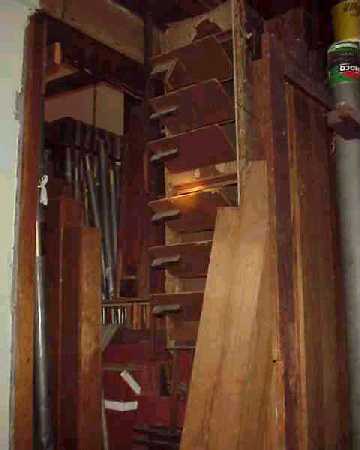Katsbaan's Historic Pipe Organ


Pipe Organ Information Provided by
Dana Hull and John Ogasapian
It is believed that the Katsbaan Pipe Organ was originally built in New York City c. 1820. In the 1850's this organ was dismantled and installed in the Saugerties Reformed Church, where it was used until 1892. It was then given to the Katsbaan Reformed Church. Amazingly, throughout this instrument's mobile history, it remains largely intact with its original workings.
Nothing substantive is know of the history of this instrument before its arrival in Saugerties. According to tradition it came from either an Episcopal or Reformed Church in New York City. However, its few stops, small pipe scales and compact size on one hand, and its fine woods and workmanship on the other, suggest the strong possibility that it was originally intended for a prosperous residence.
Although it shows traits similar to an English organ, the heavy use of walnut in the instrument indicates that it was made in America, and structural facets in the swellbox and pipes suggest a date well before 1820. Without a doubt, it is the oldest exant three-manual organ in America.
The pipes, visible in the gothic case are actually wooden dummies. In fact, the two side flats themselves are additions from the 1860's. The actual organ case, made of superb oiled walnut, and gracefully curved back at each side, is hidden behind them. Only the center pipes are real.
The pedal appears originally to have had no stops of its own; however, two sets of pipes were added in the 1860's, and their stop action is in the outer case flats. The kick-board is of rosewood, as are the keyslips and keychecks.

The compass of the keyboards on the Katsbaan organ are from a low G to a high f, with no low G# (standard practice in a G compass organ).
The pedalboard compass is from low G (includes the G#) to a C.
The stoplist is as follows: Great: Open Diapason, Stopped Diapason, Principal, Fifteenth, Sesquialtera, Copula (which is a coupler) Choir: Dulciana, Principal, Flute, Copula (couplers) Swell: Open Diapason, Cornet, Trumpet Pedal: Bourdon, Open Diapason. These two stops were apparently added later.
The original pedal was probably pull-downs (coupled). However, the pedal board now having a G# makes me wonder if the present pedalboard replaced an earlier on without a G#. Otherwise, the G# would have nothing to "pull down".
The Great manual has 46 notes: Open Diapason 8', Stop Diapason 8', Principal 4', Fifteenth 2', Sesquialtera is made up of I think two ranks (sets of pipes) and I am not sure of the pitches for this. Choir manual (also 46 notes, I think): Dulciana 8', Principal 4', Flute 4'. Swell manual is a shorter compass. I can't remember exactly how many notes. I called Charlie Ruggles, and he couldn't remember either. Anyway the stops are: Open Diapason 8', Cornet (also made of more than one rank, three I think, and I don't remember those pitches), Trumpet 8'.






~~~~~~~~~~~~~~~~~~~~~~~~~~~~~~~~~~~~~~~~~~~~~~~~~~~~~~~~~~~~~
CLICK HERE to request further information
~~~~~~~~~~~~~~~~~~~~~~~~~~~~~~~~~~~~~~~~~~~~~~~~~~~~~~~~~~~~~
BACK TO KATSBAAN PIPE ORGAN PAGE
~~~~~~~~~~~~~~~~~~~~~~~~~~~~~~~~~~~~~~~~~~~~~~~~~~~~~~~~~~~~~
LINKS TO PIPE ORGAN RELATED WEBSITES:
Central Hudson Valley chapter of The American Guild of Organists
www.chvago.org
The OrganFocus -- pipe organ events database and much more
www.organfocus.com












